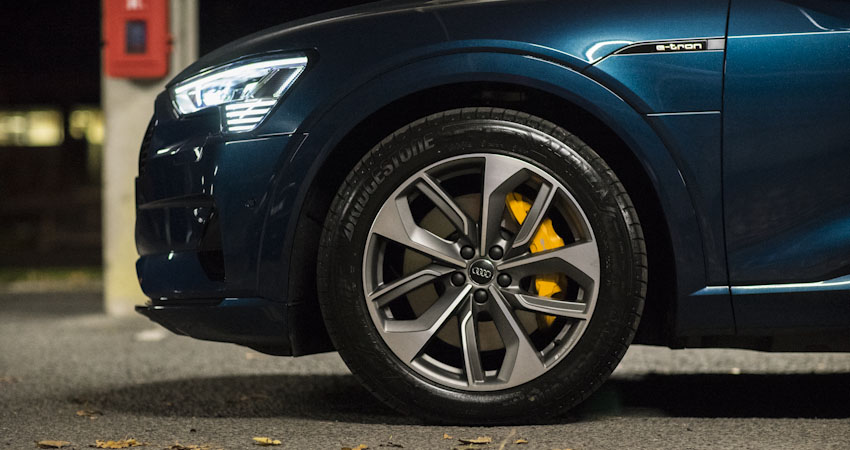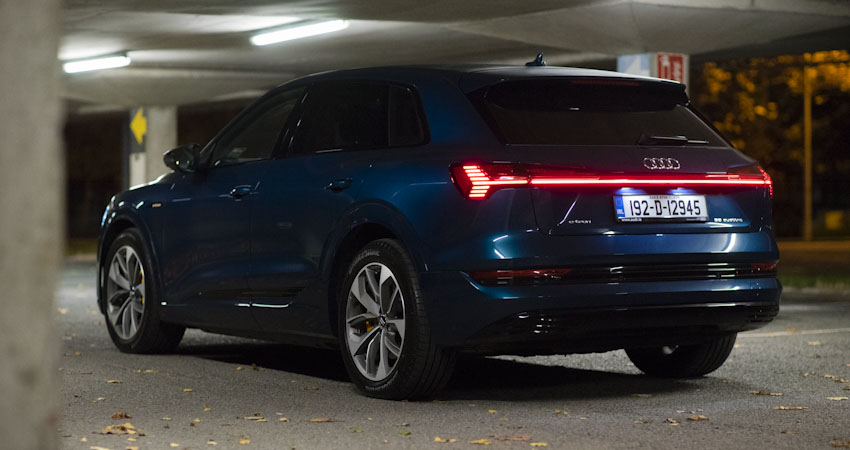
Audi’s new E-tron is their first ever production electric car and it’s hugely significant because if Audi wants to be taken seriously in the electric segment, then its first effort has to be pretty good even though it feels like the premium electric SUV segment has only just started, it’s already hugely competitive.
You’ve got competitors such as the Tesla Model X and the Jaguar I-Pace battling for premium SUV sales and Mercedes new EQC; all with decent electric ranges and desirable badges. So is the Audi E-Tron the best electric SUV on sale and how far will it really go on a full charge?
Special mention : It’s a premium SUV that’s actually friendly towards the envirmonment. Where it really excels is with its refinement, there’s hardly any wind noise and road noise and cabin tech is supreme.
Needs work : Not as dynamic as some electric cars but you get better range because of it
Specs: As tested
| Max Power 408 BHP | Electric / Auto |
| 0-100 km/h in 6.6 seconds | Road Tax €120 |
| Starting price €101,750 as tested €114,035 | Boot litres 605 – 1,755 litres |
To give some context on just how big the E-Tron SUV is, it sits between the Q5 and the Q7 in Audi’s lineup and the dimensions mean that it’s taller, longer and wider than the Jaguar I-Pace. In terms of styling, even though this is Audi’s first ever electric car they’ve kept the design as conventional as possible. Where some of the other electric vehicles on offer suffer design features to make them stand out as electric, really end up just looking like sore thumbs.
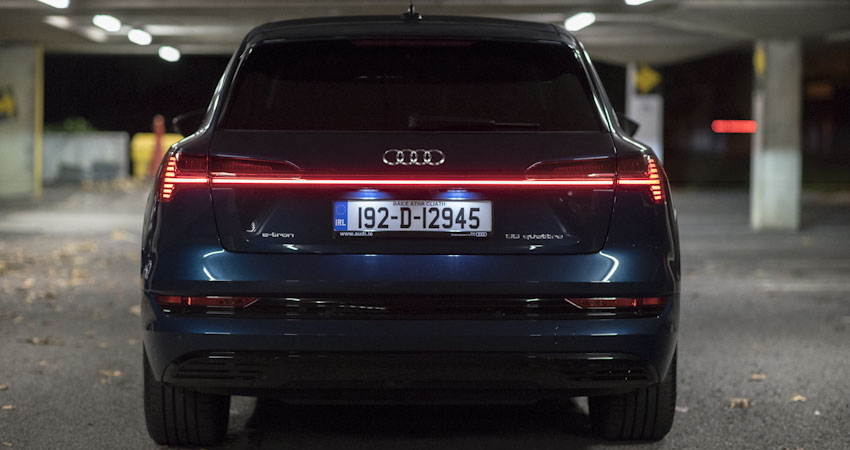
So it’s not dissimilar to the current Audi range, a couple of things stand out, the front grille is slightly different, it’s a bit plasticky (very much a texture brandished by lots of electric cars for some reason). There are strong creases on the bonnet which lead across to the e-tron name down the side. On the key fob you have E-Tron written on it as well. Thankfully the test car came with some stunning 20” contrasting grey alloys, standard Audi design spec (that is to say, spot on) and not some 80’s era electric car variant.
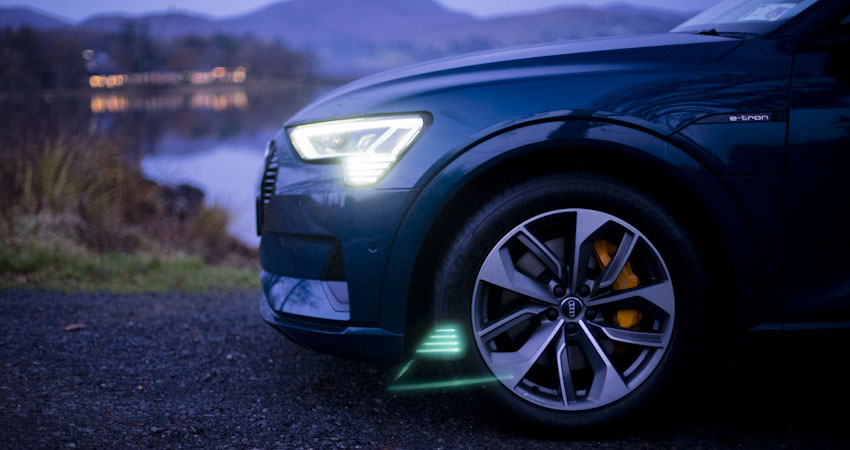
Another design feature that is not only interesting but very useful as well is that there are two charge ports one on either side which is quite rare for electric cars. To open the ‘filler cap’ you have to press a small square which doesn’t make its operation too obvious.
The interior has a pretty similar story to the exterior which means everywhere you look it’s familiar Audi territory, the tech is absolutely the latest on the market and the (as standard) Virtual Cockpit is second to none.
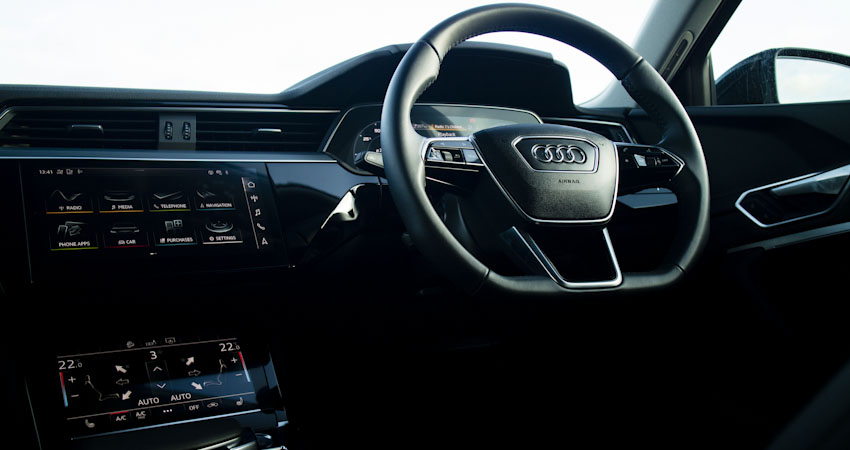
Build quality in the E-Tron is some of the best that you’ll find in the electric car class. Everywhere you touch, push or jab, is pleasant and it’s incredibly sturdy and robust, the materials are top notch Audi quality with plenty of soft touch materials.
The technology on offer is excellent as well, every E-Tron as standard, gets a 12.3” digital display with Audi’s configurable virtual cockpit. Using the View button on the steering wheel, you cycle between a couple of different views but if you upgrade the virtual cockpit on the E-Tron then it gives you a third view which just gives you a bit more information about what the electric drive system is doing, which shows up on the centre console. You’ve also got Audi’s latest MMI infotainment system.
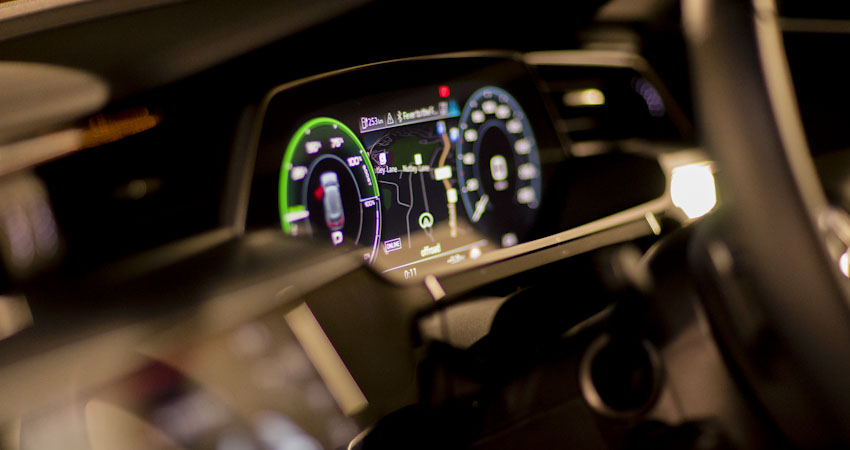
The only difference between this and a conventional Audi is you get a few extra electric car features on the E-Tron which give you some useful information about charging and how much range is left all on a 10.1” screen. Below that you’ve got an 8.6” screen with Apple Carplay / Android auto, Radio, Phone, Sat-Nav functions etc and below that you’ve got the air conditioning touch screen with ‘sliding effect’ heating/cooling controls.
If you get tired of all the screens staring at you, it’s possible to turn off the top screen which is a useful feature to have at night. In older Audi’s with the previous generation MMI system, the screen slid out of the dashboard and then slides back into the dashboard if you didn’t want to see it.
Haptic touch feedback is used most of the time, in some instances the old rotary dial and some physical shortcut buttons would do the trick, they’ve still got the analogue manual volume control which is a nice comforting touch. It’s a very good system with the technology reasonably responsive, without too much lag.
You get electrically adjustable seats with four-way adjustable lumbar support. The seating position is noticeably higher than the Jaguar I-Pace, which sticks to a lower, sportier driving position.
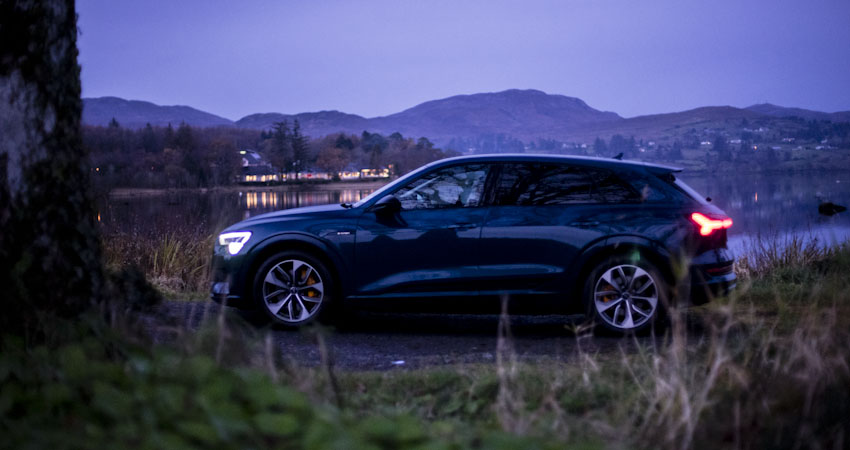
Visibility all-round is really good as well however the rear pillars are a little bit thick but you do at least get parking sensors and a reversing camera is standard plus you can get a 360 degree camera which shows a 3d view of the car and its surroundings.
If you spec virtual door mirrors, the conventional mirrors are replaced by cameras and these display their images on door mounted screens a little lower than your line of site would be.
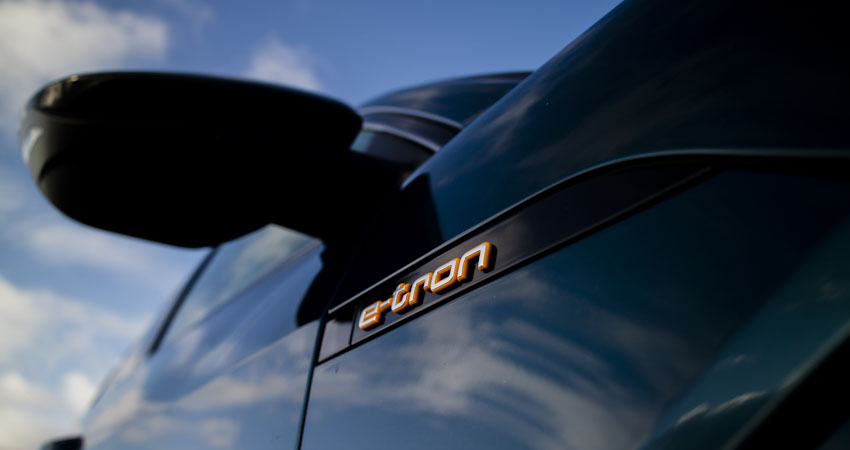
There’s plenty of headroom and loads of legroom for all passengers, comfortably fitting 4 adults and weekend luggage in the 605 litre boot. There’s good adjustability in the steering wheel as well which is electrically controlled, it’s a bit on the slow side but then all electrically adjustable steering wheels are. The storage on offer is decent as well so you have door bins which are a good size for water bottles. The centre console has decent storage space where you can also wirelessly charge your phone by dropping it into charging clip. Beside it there’s a 12 volt socket and a couple of USB ports, an SD card and a sim port. Hidden away are two cup holders which you can pop in and out. In the back, (either a glaringly obvious oversight or we just couldn’t find them), but the rear passengers had no cup holders available as standard.
The gear selector design is simple and effective, just rest your hand on the side and push forwards and backwards or press the park button to operate it.
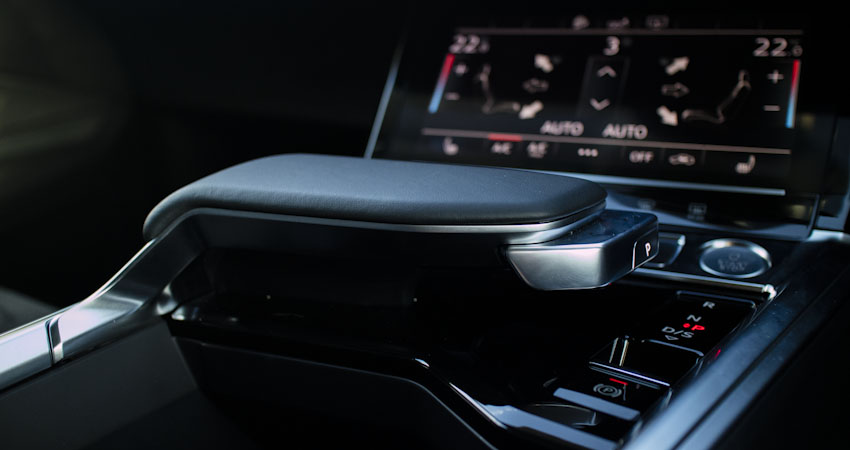
Space in the back is very generous, enough for a couple of adults to be comfortable across a 3 hour journey. Loads of leg-room and headroom, the rear bench passengers would have liked a little more thigh support in places. Rear passengers also have access to two USB ports with a 12 volt socket.
Unlike the Tesla Model X you can’t get a seven seat option, the rear seat splits 40/20/40 which is more practical than the I-Pace’s 60/40 arrangement. Boot space is impressive compared to other electric cars. There might not be quite as much storage space on offer as a Model X or Model S but you will be able to fit more carry-on suitcases into the back of the E-Tron.
Storage space under the bonnet is reserved for charging cables only. To open the bonnet it’s a more traditional latch under the drivers side. In comparison, the Model S has an enormous space in the front so it just seems a shame that both Audi and Jaguar offer a less usable area.
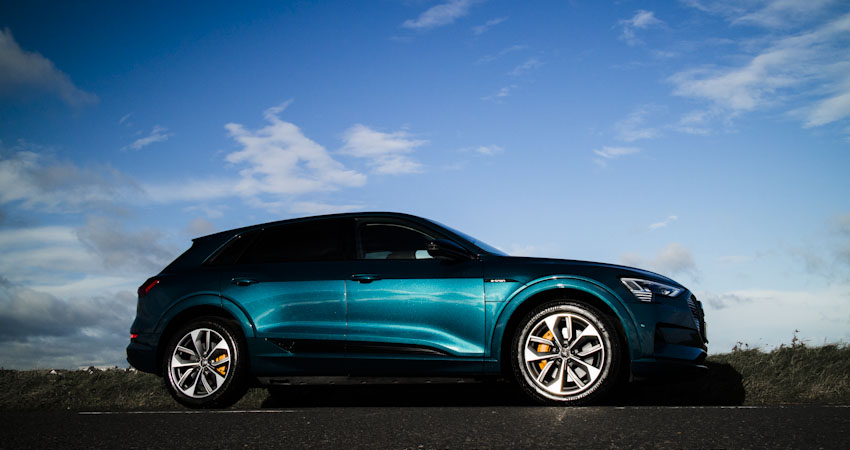
The most important thing to know about buying and owning an Audi e-tron includes how many kilometers it will travel on a full charge. In our full on range test we discovered that each charge will manage approximately 318kms in real-world driving conditions which included driving fully loaded, in freezing temperatures and on extended journeys on the motorway and some smaller, back roads. We never saw the range disappear like it does on some electric cars. Having said that, we were driving in economy mode, at average speeds, with the heating on and charging phones. Risky? Not really. For comfort, our route was planned well in advance and with a number of options and charging points at the ready should the need arise. Top ups were necessary to allow for any unforeseen incidents, luckily, there were none.
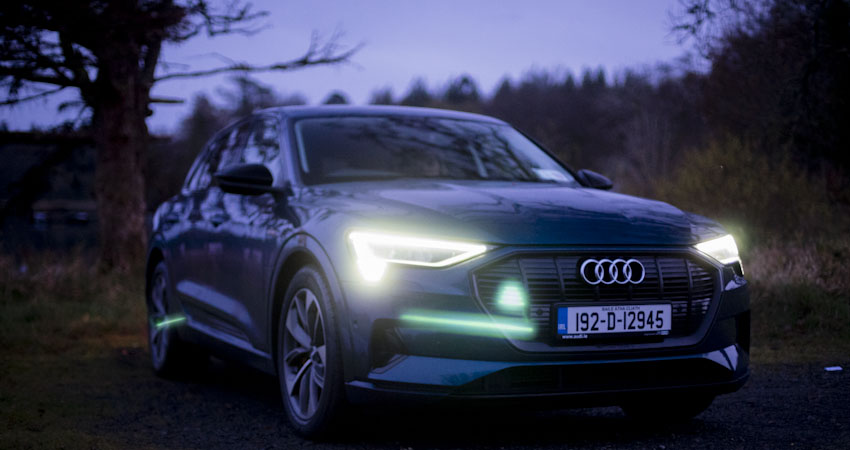
Basically if you’re buying an electric car, you will definitely need to install a home charger for peace of mind. Having one installed means a handful of weekly top ups, which can be set to last any duration from up to 100% or 80% of charge, or whatever you wish. If you were to try and rely on the public charging network, you should probably start studying for that Degree in Strategic Management now.
Electric ownership requires plenty of planning if your schedule changes a lot during the week. You need to ensure you’ve enough to not only get you to your chosen destination, but always leave enough in case, when you get there, there’s a que or even worse still, the chargers are out of operation. There are a number of handy apps to help you plan your journey better to ensure a problem free journey. During our 500km round trip test, we relied on a number of charging points from the widely used ESB E Cars, to Zap Map, Go Charge, Easy Go and Audi even have their own version to support electric car driving. If you’re banking on using a 150 kilowatt public charging point, there are currently 2 IONITY charging stations in Ireland, with more planned.
The E-Tron will go from 0 to 80% charge in just 30 minutes using a 150kw charger but if you’re using a 11 kilowatt home charger to charge the battery it will take 8.5 hours +.
The E-Tron isn’t cheap, even by electric car standards compared to the Jaguar I-Pace it’s more expensive and much more so when you compare it to mainstream electric cars like the Hyundai Kona electric and Kia e-Niro but it’s cheaper than a Tesla Model X.
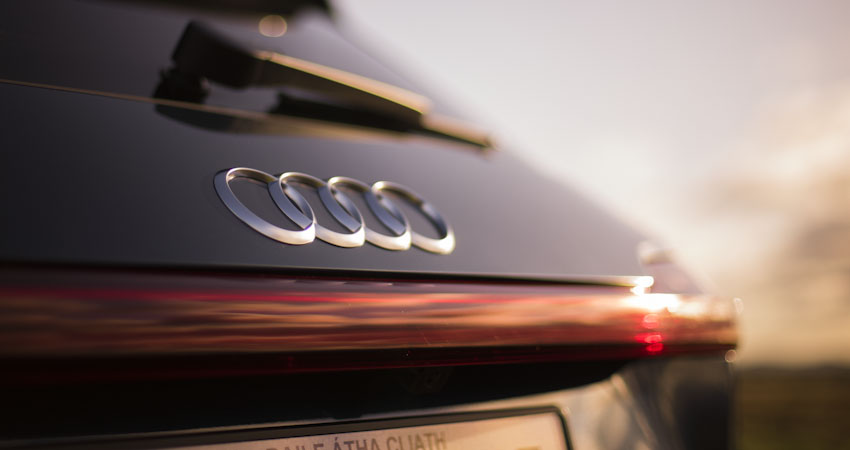
It’s predicted to have some of the strongest resale values of any car on sale plus if you get grants of up to €5,000 on EV’s over €20,000 and a €5,000 SEAI grant.
The battery is covered by an 8 year 100,000 mile warranty, similar to what Jaguar offer but Tesla don’t have any mileage restrictions on its battery cover. All models get automatic emergency braking and lane departure warning as standard first edition models also get traffic sign recognition, lane changing assistance and systems that stop you pulling into oncoming traffic and even tech that moves the driver’s seat to the optimum position to minimize whiplash if it looks like you’re about to be rear-ended.
What’s the Audi e-tron like to drive? Well it gets a 95 kilowatt-hour lithium-ion battery and two electric motors. Those two motors together produce 402 brake horsepower and that means that in a straight line a 0 – 100km/h sprint is taken care of in 6.6s. Which is very impressive for a car that weighs about 2.5 tonnes.
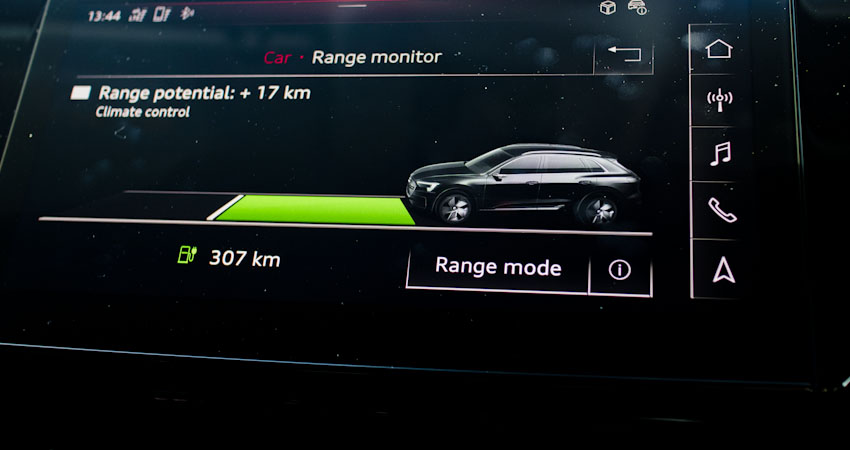
It’s slower than a Jaguar I-Pace and a Model X and you can only get that maximum 402HP in 8 second bursts. To get the maximum power you have to use the gear selector, stick it in S mode and then plant your foot, but you’ll only get that maximum power for eight seconds. The rest of the time you have 355 brake horsepower which is still quite a lot really. Most of the time, people are going to be more concerned about conserving battery life rather than embarrassing supercars off the line.
Standard air suspension does a good job of wafting you along. It does handle impressively for a car that’s this heavy and can change direction pretty quickly.
Where it really excels is with its refinement, there’s hardly any wind noise and road noise is also minimal and of course you have the very quiet electric motors which make far less noise than a petrol or diesel engine. Normally when you slow down in a hybrid or electric car the brakes can feel quite grabby or the pedal can feel inconsistent but the feel of the brake pedal in the E-Tron is one of the best in any electric or hybrid car.
The accelerator pedal is consistent in its responses too so this all means it’s very easy to drive this car smoothly. The Audi e-tron is a very impressive electric car, it’s incredibly quiet inside, spacious and luxurious plus it’s comfortable too. If your budget stretches into this realm of SUV’s then the E-Tron should definitely be on your shortlist.
